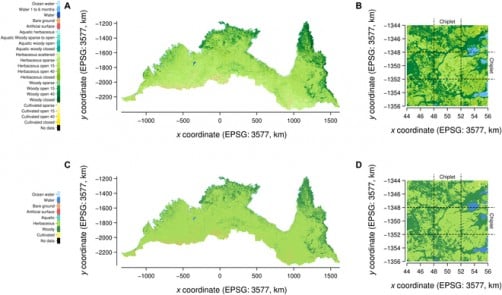
A team of researchers from the University of Melbourne has developed a groundbreaking deep learning framework called Themeda, aimed at enhancing the accuracy of land cover predictions. This innovative model, published in the Journal of Remote Sensing on September 11, 2025, addresses the critical challenges in forecasting land cover changes that affect ecosystems around the world.
Land cover changes significantly impact erosion, water quality, fire regimes, and species habitats. Despite advancements in remote sensing technologies, predicting these shifts remains a complex task. Savannas, which occupy about one-sixth of the Earth’s land surface, pose particular difficulties for researchers due to their seasonal rainfall patterns, frequent fires, and diverse vegetation. Continuous habitat loss in tropical savannas highlights the urgent need for improved predictive methods.
The Themeda framework stands out for its ability to combine advanced neural network architectures with multi-decadal satellite observations. By integrating data from 1988 to 2020, the model achieved an impressive 93.4% accuracy in predicting land cover across northern Australia’s savannas. This performance significantly surpasses the persistence baseline of 88.3%.
Innovative Technology Enhances Ecological Forecasting
The model employs a combination of ConvLSTM (Convolutional Long Short-Term Memory) and a novel Temporal U-Net design. This approach processes spatiotemporal data at multiple scales, allowing for the integration of 23 land cover classes alongside environmental variables such as rainfall, maximum temperature, fire scars, soil fertility, and elevation.
In validation tests, Themeda demonstrated a tenfold reduction in prediction errors compared to existing methodologies, achieving a Kullback–Leibler divergence of as low as 1.65 × 10−3. Notably, the model performs well even when applied to previously unseen years and locations, although extreme weather conditions, such as the particularly hot and dry season in 2019, posed challenges for prediction accuracy.
Lead author Robert Turnbull expressed enthusiasm about the framework’s capabilities, stating, “Our findings show that deep learning can move beyond static mapping toward dynamic forecasting of ecosystems.” Themeda not only provides accurate predictions but also offers transparency regarding the uncertainties involved, which is crucial for proactive land management.
Applications for Conservation and Land Management
The practical implications of Themeda extend beyond academic research. Its predictive capabilities can inform land management, climate adaptation strategies, and conservation planning. By anticipating changes in vegetation, the framework supports critical initiatives such as erosion control, hydrological modeling, and fire management strategies.
One key application involves early-season burning programs designed to reduce wildfire intensity and carbon emissions by managing fuel loads effectively. Additionally, Themeda’s approach can contribute to national carbon accounting and ecosystem restoration efforts.
The framework’s scalability allows for adaptation to other biomes, addressing global challenges related to food security, biodiversity loss, and sustainable resource use. As climate extremes become more pronounced, the need for accurate ecological forecasting like that provided by Themeda is increasingly vital.
This research received support from various initiatives, including the University of Melbourne’s Research Computing Services and the Petascale Campus Initiative. The team also acknowledges the resources provided by the National Computational Infrastructure (NCI), funded by the Australian Government.
The launch of Themeda marks a significant advancement in integrating artificial intelligence into ecological forecasting, representing a vital tool for communities and policymakers striving to safeguard biodiversity and sustain livelihoods in vulnerable regions like Australia’s savannas.







